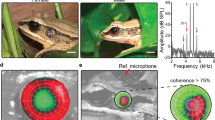Abstract
The directional hearing of male and female cicadas of the species Tympanistalna gastrica was investigated by means of laser vibrometry. The results show that the tympanic organs act as pressure difference receivers. This mechanism can produce left-right differences of more than 10 dB. The main acoustic inputs to the inner surfaces of the ears are the tympana, in males supplemented by the timbals, and by the third spiracles in females. In addition the hollow abdomen of males seems to play a minor role. Tympanic membrane input is the source of left-right differences in the tympanic vibration velocity at frequencies below 9 kHz in males and below 15–18 kHz in females. The input via the (contralateral) timbal in males is responsible for a null in vibration velocity appearing between 12 and 14 kHz when the sound is coming from the contralateral direction. The highest energy components of the calling song are found in this frequency range. The mechanical sensitivity of the ears depends upon the sex. At low frequencies males are about 10 dB more sensitive than females.
Similar content being viewed by others
References
Autrum H (1940) Das Richtungshören von Locusta und Versuch einer Hörtheorie für Tympanalorgane des Locustidentyp. Z Vergl Physiol 28:326–352
Doolan JM, Young D (1981) The organization of the auditory organ of the bladder cicada, Cystosoma saundersii. Phil Trans R Soc Lond Ser B 291:525–540
Huber F, Kleindienst H-U, Moore TE, Schildberger K, Weber T (1990) Acoustic communication in periodical cicadas: neuronal responses to songs of sympatric species. In: Gribakin FG, Wiese K, Popov AV (eds) Sensory systems and communication in arthropods. Birkhäuser, Basel Boston Berlin, pp 217–228
Michel K (1975) Das Tympanalorgan von Cicada orni L. (Cicadina, Homoptera). Eine Licht- und Elektronenmikroskopische Untersuchung. Zoomorphologie 82:63–78
Michelsen A (1983) Biophysical basis of sound communication. In: Lewis B (ed) Bioacoustics, a comparative approach. Academic Press, London, pp 3–38
Michelsen A, Larsen ON (1978) Biophysics of the ensiferan ear. 1. Tympanal vibrations in bushcrickets (Tettigoniidae) studied with laser vibrometry. J Comp Physiol 123:193–203
Michelsen A, Nocke H (1974) Biophysical aspects of sound communication in insects. Adv Insect Physiol 10:247–296
Myers JG (1928) The morphology of the Cicadidae. Proc Zool Soc Lond 365–472
Popov AV (1971) Synaptic transformation in the auditory system of insects. In: Gersuni GV (ed) Sensory processes at the neuronal and behavioural level. Academic Press, New York, pp 301–320
Popov AV (1981) Sound production and hearing in the cicada, Cicadetta sinuatipennis Osh. (Homoptera, Cicadidae). J Comp Physiol 142:271–280
Popov AV (1989) Species of singing cicadas revealed on the basis of peculiarities of acoustic behaviour. 1. Cicadatra cataphractica Popov (ex. gr. querula) (Homoptera, Cicadidae). Rev Entomol URSS 68:291–307
Popov AV (1990a) Species of singing cicadas revealed on the basis of peculiarities of acoustic behaviour. 2. Cicadetta petrophila (ex. gr. inserta) (Homoptera, Cicadidae). Rev Entomol URSS 69:579–586
Popov AV (1990b) Co-evolution of sound production and hearing in insects. In: Gribakin FG, Wiese K, Popov AV (eds) Sensory systems and communication in arthropods. Birkhauser, Basel Boston Berlin, pp 301–304
Popov AV, Sergeieva MV (1987) Sound signalization and hearing in the Baikal cicada, Cicadetta yezoensis (Homoptera, Cicadidae). Zool J 66:681–693
Popov AV, Aronov IB, Sergeieva MV (1985) Calling songs and hearing in cicadas from Soviet Central Asia. Zh Evol Biokh Fiziol 21:451–462
Popov AV, Aronov IB, Sergeieva MV (1991) Frequency characteristics of the tympanal organs and the spectra of communicative sound signals in cicadas (Homoptera, Cicadidae) from the Praskovejskaia valley. To the problem of matching between sound production and sound reception. Rev Entomol URSS 70:281–296
Pringle JWS (1954) A physiological analysis of cicada song. J exp Biol 31:525–556
Pringle JWS (1957) The structure and evolution of the organs of sound production in cicadas. Proc Linn Soc Lond 167:144–159
Shaw EAG (1974) The external ear. In: Keidel WD, Neff WD (eds) Auditory system: anatomy physiology (ear) Handbook of sensory physiology V/1. Springer, Berlin Heidelberg New York, pp 455–490
Vogel R (1923) Über ein tympanales Sinnesorgan, das mutmassliche Hörorgan der Singzikaden. Z Anat Entwickl-Gesch 67:190–231
Young D, Hill KG (1977) Structure and function of the auditory system of the cicada, Cystosoma saundersii. J Comp Physiol 117:23–45
Author information
Authors and Affiliations
Rights and permissions
About this article
Cite this article
Fonseca, P.J. Directional hearing of a cicada: biophysical aspects. J Comp Physiol A 172, 767–774 (1993). https://doi.org/10.1007/BF00195402
Accepted:
Issue Date:
DOI: https://doi.org/10.1007/BF00195402




